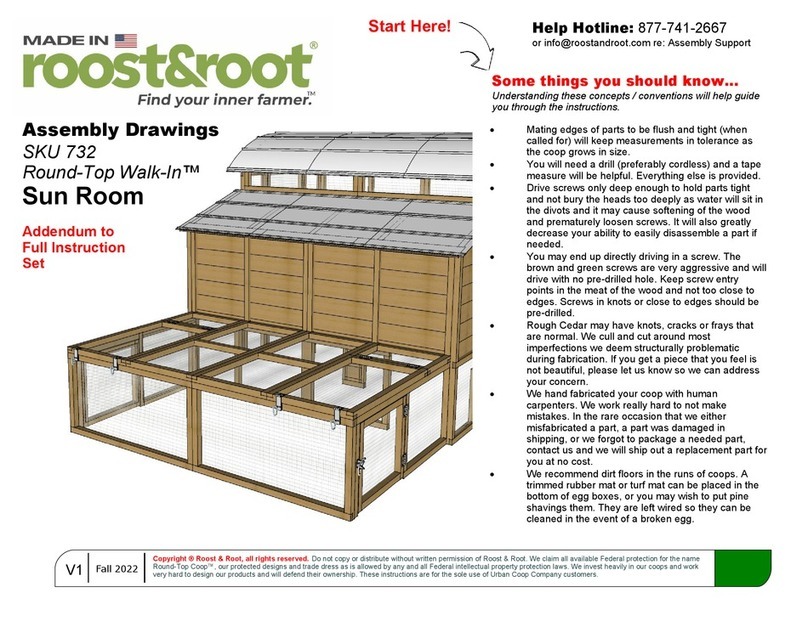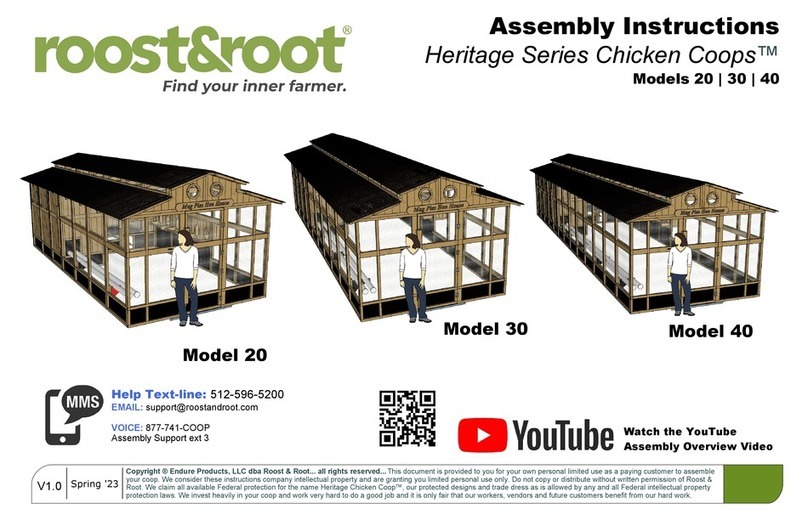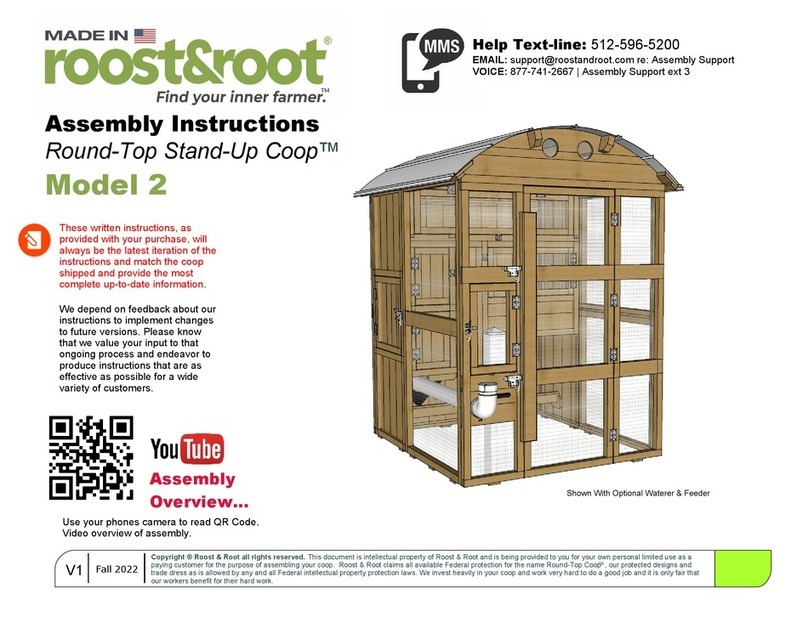roost&root Backyard Chicken Coop 2 User manual

Winter
2023
Model 2
V1.0
Standard Model Shown With Optional Smoked Roof, Waterer & Feeder
Assembly Instructions
Backyard Chicken Coop ™
These written instructions, as
provided with your purchase, will
always be the latest iteration of the
instructions and match the coop
shipped and provide the most
complete up-to-date information.
We depend on feedback about our
instructions to implement changes
to future versions. Please know
that we value your input to that
ongoing process and endeavor to
produce instructions that are as
effective as possible for a wide
variety of customers.
Assembly
Overview...
Use your phones camera to read QR Code.
Video overview of assembly.
Help Text-line: 512-596-5200
EMAIL: [email protected] re: Assembly Support
VOICE: 877-741-2667 | Assembly Support ext 3
Copyright ® Roost & Root all rights reserved. This document is intellectual property of Roost & Root and is being provided to you for your own personal limited use as a
paying customer for the purpose of assembling your coop. Roost & Root claims all available Federal protection for the name Round-Top Coop ™ , our protected designs and
trade dress as is allowed by any and all Federal intellectual property protection laws. We invest heavily in your coop and work very hard to do a good job and it is only fair that
our workers benefit for their hard work.
FOR BOTH STANDARD AND XL MODEL

Assembly Instructions
Backyard Chicken Coop
Model 2 Winter 2023 V1.1
Copyright ® Roost & Root all rights reserved.
Parts List
Tools you'll need...
A level (or use your cell phone)
Hammer
Drill... preferably
a cordless drill
with 2 charged
batteries.
Be careful not to get caught in coop. Children should not play in coop as
the doors are not designed to allow easy exit.
Spending the time up front to identify all the parts and lay them all out will
pay off in the long run and make assembly go more smoothly. The
instructions are intended to be read in page order as, the information builds
in that way, then referenced during assembly. Pre-reading the instructions
will help immensely.
Phillips Screw
Phliips Bit
Bit Holder
= Colored Arrows
Indicate Type And
Direction Of Screws
3" T25 Screw
Color of screws may vary.
T25 Torx Bit
Written Parts List
Run
A1 Left Side
A2 Right Side (door)
A3 Right Transom (thin)
A4 Front (waterer panel)
A5 Back
A6 Right Run Floor
A7 XL Sunroom Front
A8 XL Sunroom Back
A9 XL Sunroom Tops (2)
"B" Parts - Roost & Eggbox
B1 Roost Front
B2 Roost Mid Wall (egg hole)
B3 Egg Box Floor
B5 Roost Left (Door)
B6 Roost Right
B7 Roost Bars (2)
B8 Roost Back
B9 Roost Arcs (3 same)
Roof
C1 Roof Panels (3x 58")
C2 Eaves (2x)
C3 Support Battens (3)
"D" Parts - Accessories (if purchased)
D1 Waterer | Cap | 3 Nipples
D2 Waterer Bracket & Screws
D3 Feeder & Cap
D4 Sunroom Shade (Assembly)
D5 Dust Bathing Box (Assembly)
D6 Egg Box Liners (2)
D8 9 Standard Storm Panel Kit (35 Clips) xtras
D9 12 XL Storm Panel Kit (50 Clips) xtras
D10 Garden Boards Set & Liner
D11 Feeder Bezel
D12 Stakes (6x)
"F" Parts - Assembly Kit
F1 3" Screws (Standard/ #90 XL/ #100 )
F2 1-5/8 Screws ( #30 )
F3 Hasp Sets w/screws (4X)
F4 Roof Screws ( #30 x1") and ( #30 1½")
F5 Gravity Gate Latch w/screws (1x)
F6 T25 Bit (1x)
F7 Phillips Bit (1x)
F8 Bit Holder (1x)
F9 T-20 Bit (1x)
F10 Spring Snaps (5x)
Extra Screws Are Provided

Assembly Instructions
Backyard Chicken Coop
Model 2 Winter 2023 V1.1
Copyright ® Roost & Root all rights reserved.
Orientation
Front
Left
Right
Back (We recommend having the back side of your coop facing North)
XL Model Shown With Optional Waterer, Feeder and Roof.
XL
Egg Box
Water
Feed
Roost
Egg
Collection
Roost Door
Vent
Vents
Water
Support
Bracket
Turn Out
Door

Assembly Instructions
Backyard Chicken Coop
Model 2 Winter 2023 V1.1
Copyright ® Roost & Root all rights reserved.
Concepts
Sorry... a little reading ;-)
Sealing & Care:
We recommend you leaving your coop natural. You can stain your coop but should only use a "breathable" low VOC water based stain. You can have color added to these products
too...like painting, but it's a wood stain that lets the wood breathe. Cedar will last outdoors in its natural state for many years, better than almost any other wood. Sealing can keep the wood
from going grey. That's the main benefit. Clean wood with mild detergent and water or with a commercially available coop cleaner as needed. Glues used in all joints are completely
waterproof and all metal parts are galvanized or have exterior rated coatings.
Placement:
Easy access to water/feed and clear access to doors is needed. Sunlight is not all bad, and the roof does provide shade. Sunlight does a good job at disinfecting the ground under the coop.
Fifty percent (50%) or more of direct sun is preferred. Good air movement around your coop is more important than anything else. The proper side should face North if at all possible.
Remember... High ground is dry ground. For coop doors to open easily over time, the coop must be level.
Digging Predators:
Diggers are the prime nuisance to chickens. By far dogs are the most common digger. Other "wild" animals, while more rare, certainly can dig too. If you ’ re worried about diggers, stack
heavy block shaped rocks around perimeter of coop to make getting under more difficult. Better yet, bury them around the perimeter just below grade. You can also attach a strip of wire that
extends out from the bottom rails, and bury below the surface of the soil. We recommend dirt in bottom of coops that has good drainage. Pine shavings, straw or shredded junk mail can be
used in laying areas... but is not recommended in the main run areas.
More About Cedar:
Your coop is built from rough cut domestic cedar. Our 2x2's are actually custom milled. Wood deemed defective is culled during milling, cutting and in fabrication... about 5%-10% does not
"make the cut". Knots, blemishes, fraying, coloring variations, minor surface cracking, slight warping and periodic worm marks are normal parts of natural wood products. We try to make it to
where a reversible part always has a “ pretty side ” and take care to make the “ pretty side ” show on all parts. If you ’ re unhappy with a piece of wood we fabricated into your coop, send us a
picture. We want you to love every piece of your new coop.
Staking for Wind:
If you expect your coop to be in winds greater than 35mph (tropical storm force wind) then you will want to stake your coop to the ground in a way that is appropriate for your soil
and locale. You can always contact us for guidance related to your particular situation.
Understanding these concepts / conventions will help guide you through the instructions.
1 Mating edges of parts to be flush and tight (when called for) will keep measurements in tolerance as the coop grows in size.
2 CRITICAL: Having a flat area is required for the coop to assemble properly and operate properly.
3 We estimate about 2 hours for someone of ordinary skill to assemble. Two people will certainly make some steps easier.
4 You will need a drill (preferably cordless) maybe a tape measure and a hammer. Everything else is provided.
5 Drive screws only deep enough to hold parts tight and not bury the heads too deeply as water can sit in the divots and it may cause
softening of the wood and prematurely loosen screws. It will also greatly decrease your ability to easily disassemble a part if needed.
6 You may end up directly driving in a screw. The provided screws are very aggressive and can drive with no pre-drilled hole. Keep screw
entry points in the meat of the wood and not too close to edges. Screws in knots or close to edges should for sure be pre-drilled.
7 Rough Cedar may have knots, cracks or frays that are normal. We cull and cut around most imperfections we deem structurally problematic
during fabrication. If you get a piece that you feel is not beautiful, please let us know so we can address your concern.
8 We hand fabricated your coop with human carpenters. We work really hard to not make mistakes. On the rare occasion that we either
misfabricated a part, a part was damaged in shipping, or we forgot to package a needed part, contact us and we will ship out a replacement
part for you at no cost.
9 We recommend dirt floors in the runs of coops. A trimmed rubber mat can be placed in the bottom of egg boxes and you may wish to put
pine shavings or shredded junk mail in them. They are left wire so they can be cleaned in the event of a broken egg.

Assembly Instructions
Backyard Chicken Coop
Model 2 Winter 2023 V1.1
Copyright ® Roost & Root all rights reserved.
Step 1A - Run
1A1 Left Front Corner: Using the provided T25 Torx Bit
in provided Bit Holder and your drill, drive 3" T25 Screws
from panel A4 into panel A1 through pre-drilled holes.
Panel A1 overlaps panel A4 as illustrated. Wire side goes
to the inside. Make edges and tops flush. (The top of the
A1 panel will have pre-drilled holes from the underside
going up.)
1A2 Left Back Corner: Drive 3" T25 Screws from panel
A5 into panel A1 through pre-drilled holes. Panel A1
overlaps panel A5 as illustrated. Wire side goes to the
inside. Make edges flush and top of A1 flush with the A5
mid-rail as illustrated by the dashed red line.
1A3 Right Side: Drive 3" T25 screws (2 of them) from
inside of A4 and A5 panels into the A3 right side transom
panel. Top of A3 is flush with tops of A4 and A5 and
attaches onto the outside as illustrated.
:-) Here we go !
= Direction
Of Screws
3" T25 Screw
Color of screws may vary.
A5
The first step is to attach the left and right sides to the
front and back panels to form the "run". The run is
where your chickens will live during daylight hours.
Your local dirt makes the best surface and will allow
chicken poop to decompose more readily and lets
your birds get a "dust bath" when they need. It's also
easy on their feet.
Left
Side
Back
This wire removed
if you ordered a waterer.
Make side
edges flush
Make Bottoms
Flush
A1
A4
A5
Flush Tops
A3
A3
A3 Top Flush with
A5 & A4 Top Rail
Flush Edges
Flush Tops
Front
Right
Side
An extra person while
not required, would
be helpful for these steps.
While certainly not
mandatory, best practice
would be to "square"
the run by measuring
corner to corner as
illustrated by the orange
lines in the top figure and "rack"
(move) the run from corner to corner
until the two measurements were the
same.
See note
about
"squaring".
Corner-to-
Corner
should be
+/- 76
inches...
*Wire goes to inside of
coop...
A1
Pre-Drilled
Holes In
Top Edge
Only drive screws deep enough for them to
hold. The hole from driving them too deep
holds water and causes premature loosening.
Other roost&root Farm Equipment manuals
Popular Farm Equipment manuals by other brands

Schaffert
Schaffert Rebounder Mounting instructions

Stocks AG
Stocks AG Fan Jet Pro Plus 65 Original Operating Manual and parts list

Cumberland
Cumberland Integra Feed-Link Installation and operation manual

BROWN
BROWN BDHP-1250 Owner's/operator's manual

Molon
Molon BCS operating instructions

Vaderstad
Vaderstad Rapid Series instructions














